Understanding ABI encoding for function calls
ABI encoding is the data format used for making function calls to smart contracts. It is also how smart contracts encode data when making calls to other smart contracts.
This guide will show how to interpret ABI encoded data, how to compute the ABI encoding, and teach the relationship between the function signature and the ABI encoding.
Let’s get into it…
Solidity abi.encodeWithSignature and low-level calls
If we were to make a low-level call to another smart contract with a public function foo(uint256 x) (passing x = 5 as the argument), we would do the following:
otherContractAddr.call(abi.encodeWithSignature("foo(uint256)", (5));We can look at the actual data returned by abi.encodeWithSignature("foo(uint256)", (5)) with the following code:
function seeEncoding() external pure returns (bytes memory) {
return abi.encodeWithSignature("foo(uint256)", (5));
}and we would get the following result (which is ABI encoded):
0x2fbebd380000000000000000000000000000000000000000000000000000000000000005Interpreting and understanding this data like this is the goal of this article.
The key components of an ABI encoded function call
An encoded ABI function call is the concatenation of the function selector and the encoded arguments to the function (if the function takes arguments).
The function signature
The function signature is the combination of the function name and its argument types without spaces.
For example, the function signature for the function below:
function transfer(address _to, uint256 amount) public {
//
}is transfer(address,uint256). Note that you must use the full argument data types, such as uint256 instead of uint. Also, the variable names like the _to and amount are not part of the function signature. It is also important that there are no spaces in the string such as transfer(address, uint256).
Per the Solidity documentation, there are some "corner cases" to be aware of when computing the function signature:
- Structs are treated like tuples
- Payable addresses, interfaces, and contract types are treated as addresses
- The "memory" and "calldata" modifiers are ignored
- An enum is uint8
- A user defined type is treated as its underlying type
The function selector
The function selector is simply the first 4 bytes of the Keccak-256 hash of a function signature that Solidity uses to identify a function. For example, the Keccak-256 hash of our previously mentioned function signature transfer(address,uint256) is this hexadecimal value:
0xa9059cbb2ab09eb219583f4a59a5d0623ade346d962bcd4e46b11da047c9049bHowever, only the first 4 bytes of the hash result 0xa9059cbb is used to identify the function; those four bytes are the function selector.
You can use the ethers JavaScript library to convert the transfer() function signature to its selector as shown below:
const ethers = require('ethers'); // Ethers v6
const functionSignature = 'transfer(address,uint256)';
const functionSelector = ethers.id(functionSignature).substring(0, 10)
console.log(functionSelector);The result would be like this:

In Solidity, this function computes the function selector:
function getSelector() public pure returns (bytes4 ret) {
return bytes4(keccak256("transfer(address,uint256)")); // 0xa9059cbb
}You can also use this keccak256 conversion website to see the conversion without writing any code:
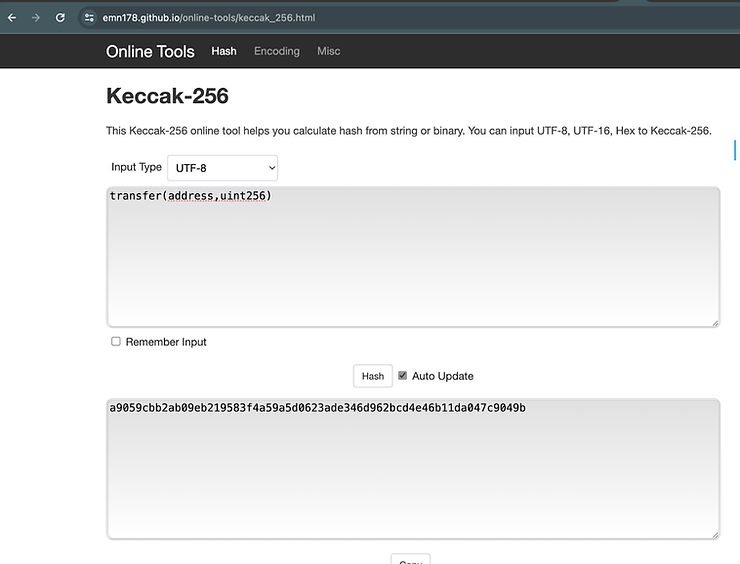
Now that we have a clear understanding of what the function selector is, let’s consider the next component of an ABI encoding for function calls — function inputs or arguments.
Function inputs or arguments
When calling a function that takes no arguments, the function selector alone will be all the encoding needed to call the function. For example, the function play() will be identified by its function selector 0x93e84cd9 and that will be the entire data needed.
However, it gets complex if the function takes arguments, such as transfer(address to, uint256 amount), then the function arguments must be ABI encoded and concatenated to the function selector.
Let’s use transfer(address to, uint256 amount) as a running example to help us understand how the argument encoding is done:
function transfer(address to, uint256 amount) public {
//
}This data for the function call isn’t stored permanently within the function or the contract itself. Instead, it lives in a space called "calldata." You cannot modify the data in calldata, as it’s created by the transaction sender and then becomes read-only.
You can see the calldata of a transaction in Etherscan. Below is a screenshot showing an example of transfer transaction calldata for an example ERC-20 token:
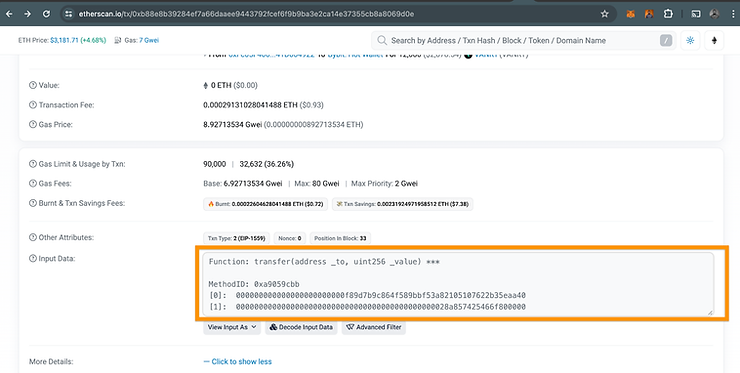
Etherscan refers to the function selector as MethodID below the function description (see the red box in the screenshot below). So the methodID for transfer() is 0xa9059cbb.
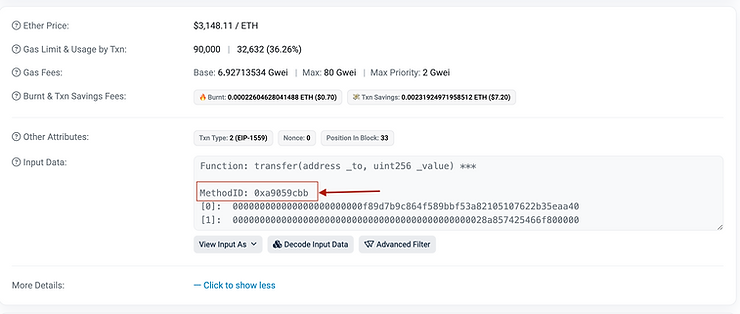
Then what follows are two long hexadecimal values tagged as [0] and [1]. Those hexadecimal values represent the two input data arguments: the _to, address and the _value, uint256.
Etherscan helps us separate and interpret the calldata information into 32-bytes (64 characters) per line. However, the actual calldata will be bundled together and sent as one long string and it should look like the one below:
0xa9059cbb000000000000000000000000f89d7b9c864f589bbf53a82105107622b35eaa4000000000000000000000000000000000000000000000028a857425466f800000You can also see the actual complete calldata in its original format on Etherscan by clicking on the "View input as" and selecting the "Original" option as shown below:

To better understand what’s happening under the hood, let’s break down the calldata and extract the relevant information of the transaction.
Dividing the calldata
Let’s consider the calldata below and identify its components:
0xa9059cbb0000000000000000000000003f5047bdb647dc39c88625e17bdbffee905a9f4400000000000000000000000000000000000000000000011c9a62d04ed0c80000First, we need to know the function signature — without that we cannot decode the data. So, here is the function signature for the above calldata:
transfer(address,uint256)We then put the hexadecimal notation (0x) and the function selector on their own line. The function selector is always 4 bytes (8 hex characters). Finally, we divide each of the following 32 bytes into their own line. As we will see later, Solidity encodes the data in 32-byte increments.
0x <---------- Hexadecimal notation
a9059cbb <---- Function selector
0000000000000000000000003f5047bdb647dc39c88625e17bdbffee905a9f44
00000000000000000000000000000000000000000000011c9a62d04ed0c80000Function selector
The function selector is the first 4 bytes of the calldata 0xa9059cbb.

Address
The address in transfer(address,uint256) is the next 32 bytes value. The actual address is 20 bytes but it is left padded with leading zeros to make it 32 bytes.
Address:
000000000000000000003f5047bdb647dc39c88625e17bdbffee905a9f440

Essentially, the receiver address will be the value above but without the extra zero paddings: i.e. 0x3F5047BDb647Dc39C88625E17BDBffee905A9F44.
Amount
And finally, the last item in transfer(address,uint256) is the amount. The amount (0000000000000000000011c9a62d04ed0c80000) is left-padded with leading zeros to become 32 bytes as shown below:

Here is a Python snippet to help you quickly convert hexadecimal to decimal:
>>> int("0x11c9a62d04ed0c80000", 16)
5250000000000000000000And we can also convert the decimal back to hexadecimal as shown below:
>>> hex(5250000000000000000000)
0x11c9a62d04ed0c80000Data types and padding
We’ve established that each item in calldata is encoded as a 32-byte word and padded with zeros if the item doesn’t take up the entire 32-byte word.
As a rule, every fixed-size data type such as int, bool, and uint of all sizes (unit8-uint256) will be encoded as a 32 bytes word padded to the left with zeros if needed.
For example, if you have a uint8 with a value of 5, it will be encoded as
0x0000000000000000000000000000000000000000000000000000000000000005.
Similarly, a bool with a true value would also be left padded and encoded as 0x0000000000000000000000000000000000000000000000000000000000000001.
However, the dynamic sized data types bytes and string are right padded. For example, the bytes 0x68656c6c6f which represents hello will be encoded as a 32-bytes word padded with zeros to the right 0x68656c6c6f000000000000000000000000000000000000000000000000000000.
Fixed-sized data types in Solidity include:
- bool
- uints
- bytes of fixed size (bytesN)
- address
- tuple, struct with fixed data
- fixed-size array
Below are the dynamic data types in Solidity:
- bytes
- string
- dynamic array
- a fixed-size array that contains dynamic types
- a struct that contains any of the above dynamic types
Working with dynamic calldata
So far, our focus has been on static calldata argument types like address and uint256. While static types are fairly straightforward to encode, encoding arrays and strings can be a bit complicated due to the varying size of data they hold.
Let’s consider a function that takes an array of uints and a single address. While the implementation details for our function are not relevant here, the function signature should look like this:
transfer(uint256[],address)Now, let’s move our focus to encoding the array. Let’s assume we are passing the following data to the transfer function:
transfer([5769, 14894, 7854], 0x1b7e1b7ea98232c77f9efc75c4a7c7ea2c4d79f1)This is the calldata for our example function above with the signature transfer(uint256[],address). Let’s examine it and see how every part is encoded following the pattern we described above.
First, we’ll start with encoding the "offset" of the array uint256[] but what is an offset?

Offset
The offset is used to locate within the calldata where specific dynamic data starts or can be found.
Following our example, we have one dynamic datatype uint256[] and a static type address. The offset of uint256[] in the above calldata is 40 in hexadecimal (64 in decimal) and its encoding takes up 32 byte words.
Since the dynamic array is the first argument to the function, the offset is the first 32-byte word in the calldata:

To further explain how the offset works, the image above highlights where the offset of the array is located in the calldata. Each byte word is numbered from
- 0-31 (the first row of 32 bytes)
- 32-63 (the second row of 32 bytes)
- 64-95 (the third row of 32 bytes)
- etc
So 64 (40 hex) is the leftmost byte (pair of hex characters) on the third row where the green highlight ends. This is where the offset is pointing.
In this example, the offset is the distance from the start of the first byte after the function selector to where the dynamic data (array) starts. We will see later however, that the offset does not always mean "offset from the first byte after the function selector."
Encoding the static data — the address
The next line is the address, which is a static 32-byte word padded with leading zeros. It’s the same address we already passed in, since the address is already in hexadecimal format.
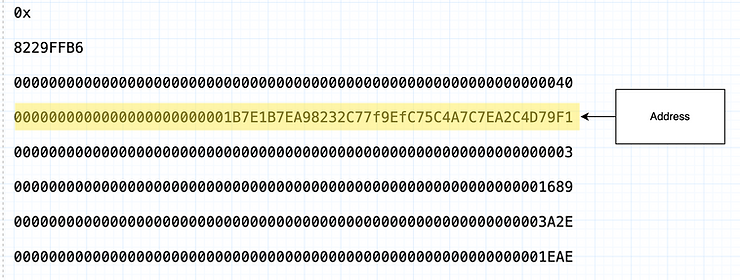
Encoding the length of a dynamic data — the array
The next line is the length of the array, which is the number of items in the array. As you can see, we have 3 items in the array: [5769, 14894, 7854]. The length of the array is 3 as represented in the image below:
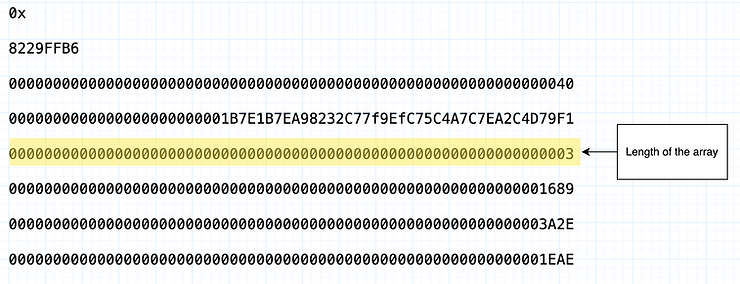
Hex encoding array elements
So far, we’ve encoded the static type, the offset, and the length of the array. Next, let’s encode the actual array elements. Each element of the array will be represented as a hexadecimal number like the image below:
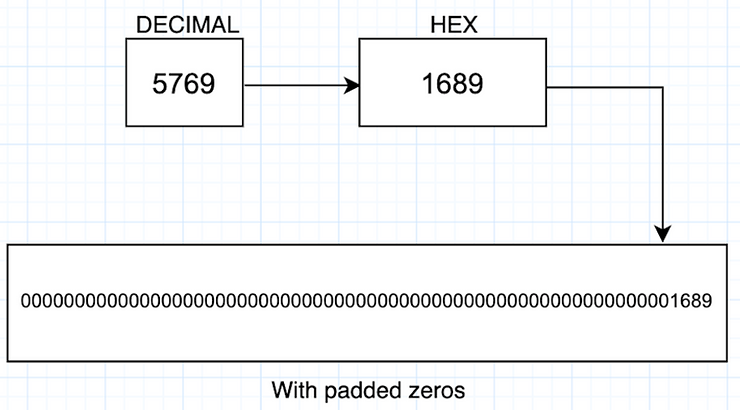
We convert each of the integers to their hexadecimal representation and add leading zeros to them. So, the array items will be the following:
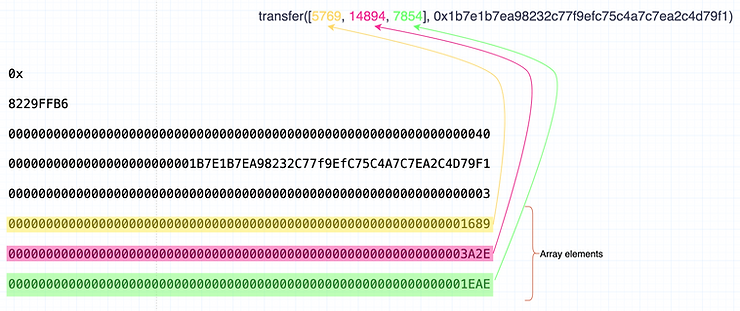
This completes our discussion of the calldata of this ABI encoding.
The following video summarizes everything we learned about how to encode calldata for transfer(uint[], address):
ABI encoding a string argument
Encoding a string is straightforward, you only need to encode the following:
- the offset
- the length of the string
- the content of the string (UTF-8 encoded)
Here is an example using a function that contains a string argument:
play(string)When we pass in a value:
play("Eze")the calldata will be the text below:
0x
718e6302
0000000000000000000000000000000000000000000000000000000000000020
0000000000000000000000000000000000000000000000000000000000000003
457a650000000000000000000000000000000000000000000000000000000000The offset is represented as 20 in hexadecimal, as the position of the string encoding is just 32 bytes (32 in decimal is 20 in hexadecimal) away from the beginning of the calldata after the function selector. We can also see that the length of the string (Eze) is 3 as there are just 3 characters in the string, one byte each (one byte is two hex chars).

The string "Eze" is only using ASCII characters which take one byte each (hence a length of 3). However, unicode characters like "好" take up 3 bytes. The maximum size a utf-8 character can be is 4 bytes. The string "你好" has a length of 6 bytes.
Encoding structs/tuples in a calldata
Tuples and structs are encoded identically because structs are mapped to the ABI type tuple.
According to the Solidity ABI encoding specification, the encoding of a struct is the concatenation of the encoding of its members, with the static types padded to 32 bytes.
Suppose we have the following contract:
contract C {
struct Point {
uint256 x;
uint256 y;
}
function foo(Point memory point) external pure {
//...
}
}The function signature of foo would be foo((uint256, uint256)). This is no different than if it took a tuple as an input. If it took a dynamic array of points (structs), the function signature would be foo((uint256, uint256)[]).
If a struct’s element are all fixed-size data, we’ll encode the entire struct as static type and there will be no need for an offset. However, the encoding of the struct will change if it has a dynamic-sized data type as at least one of its field.
For example, a struct like this one below:
RareToken {
uint256 n;
}
send(RareToken,address)will be encoded as a static type if we pass the following arguments to it send( RareToken(1), 0x1b7e1b7ea98232c77f9efc75c4a7c7ea2c4d79f1)) as demonstrated in the next image:
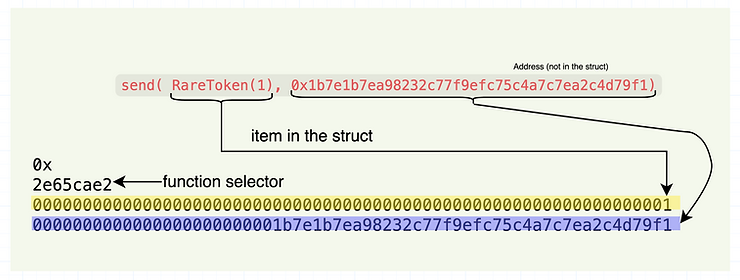
However, if there is a dynamic type in the struct, we’ll have to encode the struct as a dynamic type. Let’s take this one as an example:
RareToken {
uint256;
string;
}
send(RareToken)The encoding of the function above would be the code in the image below if we pass the following data to it send(RareToken(50,"Eze")) . The struct contains one dynamic type and a static type as shown in this diagram:

ABI encoding multiple struct arguments
Now, suppose our function send() took 3 structs as arguments instead of one. The calldata would be as follows:
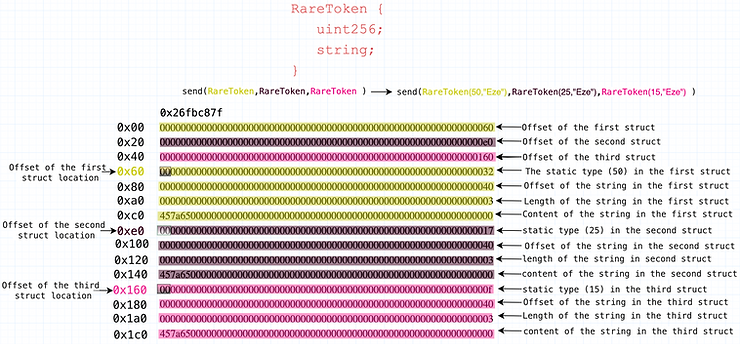
The first three 32-byte words are offsets because the function takes 3 arguments as input, and each of those arguments are dynamic data types (structs with a dynamic type field).
The column of 0x00, 0x20, …, 0x1c0 on the left shows how the offset points to the location in calldata. Note that the offset starts from the first offset, not from where the offset is located. We’ll explore offsets more when we look at nested dynamic data.
Encoding a fixed sized array with static type
Encoding fixed size arrays depends on the content in the array, if the fixed size array contains dynamic types then the fixed size array will be encoded as a dynamic type. If it contains only static types, it will be treated as a static type an encoded as such. This follows the same logic as a struct that contained dynamic data as shown in the above section.
Let’s start with a fixed size array of only static types with length of 3:
play(uint256[3])and pass this data to it:
play([1,2,3])And here is the encoding of the array:

As you can see there are no offsets in the calldata. It’s just the encoding of the elements of the array.
Encoding a fixed sized array holding a dynamic type
Let’s consider a scenario where the fixed size array contains dynamic data. The function below will contain an array of two strings.
plays(string[2])If we pass the following strings to it:
play(["Eze","Sunday"])We’ll get this calldata when encoded:

Because the fixed size array was an array of dynamic data types, its entirety was encoded as a dynamic array, the only difference is that the length of the array was not encoded because the function signature defined it as a fixed length array of 2. If we consider the same function but with dynamic length:
plays(string[])we’ll notice that the length of the array will be encoded also:

Multiple array arguments and nested arrays in calldata
Working with multiple and nested arrays in calldata can be a little complex and tricky. However, the general pattern remains similar. In this section, we’ll learn how to encode and decode nested arrays and get a better intuition for how the offset works.
We’ll use the following function signature as an example:
transfer(uint256[][],address[])Let’s also pass the following data as arguments to the function:
transfer([[123, 456], [789]], [0x5B38Da6a701c568545dCfcB03FcB875f56beddC4, 0x7b38da6a701c568545dcfcb03fcb875f56bedfb3])So, the calldata for this function and the argument will be the hexadecimal below:
0x7a63729a
0000000000000000000000000000000000000000000000000000000000000040
0000000000000000000000000000000000000000000000000000000000000140
0000000000000000000000000000000000000000000000000000000000000002
0000000000000000000000000000000000000000000000000000000000000040
00000000000000000000000000000000000000000000000000000000000000a0
0000000000000000000000000000000000000000000000000000000000000002
000000000000000000000000000000000000000000000000000000000000007b
000000000000000000000000000000000000000000000000000000000000007b
0000000000000000000000000000000000000000000000000000000000000001
000000000000000000000000000000000000000000000000000000000000007b
0000000000000000000000000000000000000000000000000000000000000002
0000000000000000000000005b38da6a701c568545dcfcb03fcb875f56beddc4
0000000000000000000000007b38da6a701c568545dcfcb03fcb875f56bedfb3The new feature of our transfer() function is that it has two arrays, and one of those arrays has two sub-arrays.
Here’s how a calldata structure for a nested and multiple array is constructed on a high level:
- Offsets. It starts with defining the offsets for the different locations of the arrays. Assuming there are multiple array arguments, the encoding of the offsets of those arrays will be defined first. For our example, there will be two offsets.
- Offset to the first dynamic type
- Offset to the second dynamic type
- Offset to the
nthdynamic type (where applicable)
- The length of the first array parameter (2 in our example:
[[123, 456], [789]]) comes next and lives where the first offset points. This is the length of the entire array. Before you start working on each array, you begin with defining its length. So for every sub-array, you’ll define their length (later in the ABI encoding). - Next, encode the sub-arrays of the first array parameter
- Offset to the first sub-array (
[123, 456]) - Offset to the second sub-array (
[789])- Length of the first sub-array (2 in our example)
- First item of the first sub-array(
123) - Second item of the first sub-array(
456)
- First item of the first sub-array(
- Length of the second sub-array (1 in our example)
- First item of the second sub-array(
789)
- First item of the second sub-array(
- Length of the first sub-array (2 in our example)
- Offset to the first sub-array (
- Once you are done with all the items of the first array parameter, start encoding the next array parameter
- Length of the second parameter array (2 addresses in our example)
- and elements of the second parameter (the addresses in our example), if the second array parameter has sub-arrays, you follow the same pattern as described above.
Now, let’s visualize the calldata of our example.
First, arrange it in 32 bytes (64 characters) per line, aside from the 0x and the function selector, to make it easier to read. The function signature and calldata are at the top of the image:
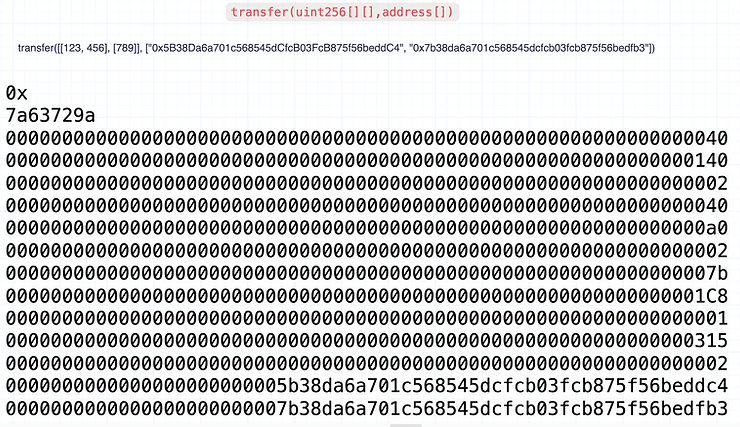
Offset of the first array argument
The first 32-byte word of the calldata string is the offset, indicating where the data for the first array parameter starts. Here is a visual representation:
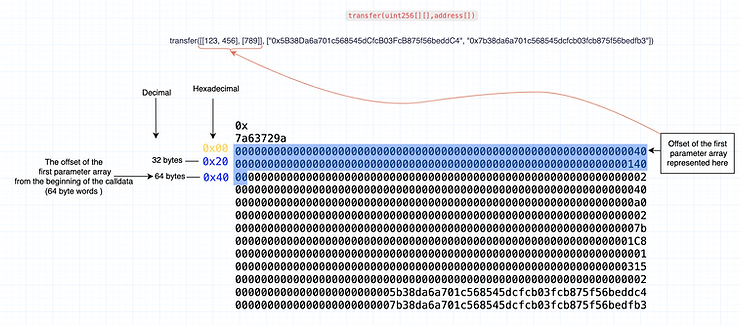
Offset of the second array argument
The next step is the encoding of the offset for the second array argument.
As we saw with the example of multiple dynamic structs, this offset does not "start counting" from the location of the offset, but from the first offset.
Offsets do not in general "start counting" from their current location, but from the first offset that described that "level" of the nested data structure. This concept will become more clear as we explore the sub arrays.
The image below highlights how the second offset points to the second argument data (the array of addresses). Note that the offset is pointing to a "2" as the second argument is an array of two addresses.

Since each byte word is numbered from:
- 0-31
- 32-63
- 64-95
- etc
320 bytes (140 hex) is the leftmost 0 on the row where the highlight ends.
Length of the first array
Next, we need to encode the length of the first array. The sub-array items include [123, 456] and [789], which forms [[123, 456], [789]]. Since there are two nested arrays, the length is 2. The length is represented in the calldata as shown below:
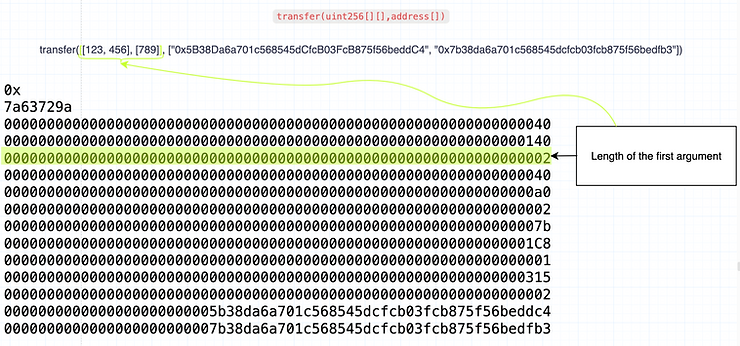
Offsets of the sub-arrays in the first array argument
After the length of the array, we have the offsets that shows where the content of those arrays are stored. There are two offsets, since there are two subarrays: [123, 456] and [789].
Offset of the first sub-array
The offset of the first sub array([123,456]) is the 40 pointed to by the box on the right. Both of them "start counting" from the first word after the length that defines the array. Again, note that it is pointing to a word holding a 2 because [123,456] is of length 2.
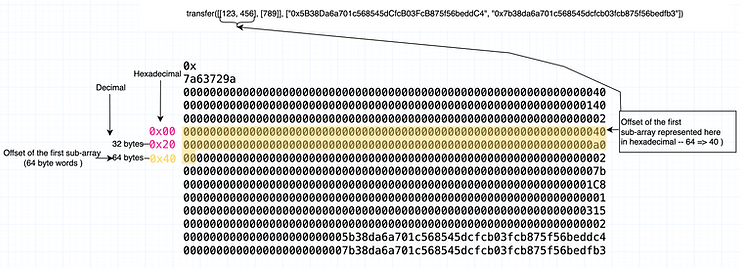
Offset of the second sub-array
The offset of the second sub-array ([789]) doesn’t start from the beginning of the calldata. It’s located at a0 (the last red highlight in the image below) which is 160 bytes (in decimal) from where the first sub-array offset is declared.
Recall that offsets do not in general "start counting" from their current location, but from the first offset that described that "level" of the nested data structure. We are now one level deep in the nested array, so our first offset is the 40 highlighted in purple below. This offset does not start counting from its own location:
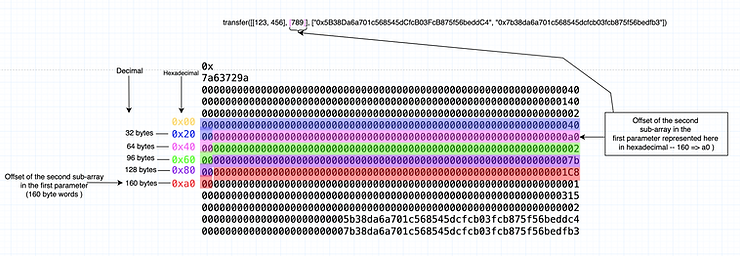
The length of the first sub-array
The length of the first sub-array comes next. The first sub-array contains 2 items and is identified by the yellow highlight below:
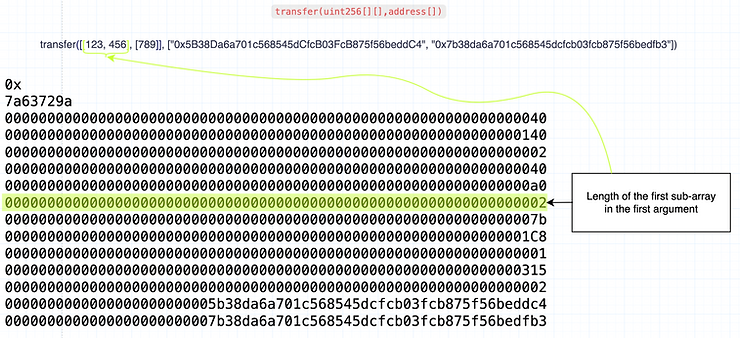
The items in the first sub-array
The next two words are the hex representations of the two items in the first sub-array as shown in the image below:
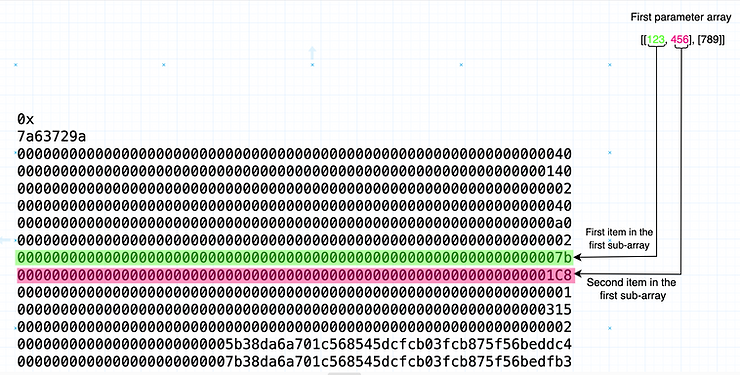
The length of the second sub-array
Then we move to the length of the second sub-array which only holds one item:
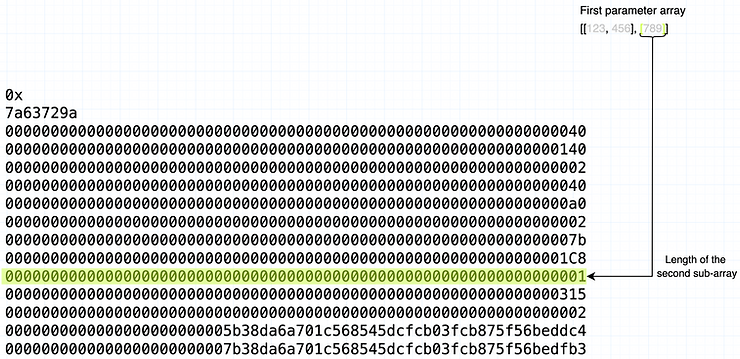
The item in the second sub-array
The second array has only one item, as you can see from its length. We also represent the value of the single item in the array (315), which is the hex value of 789, in the next 32 bytes, as shown below.
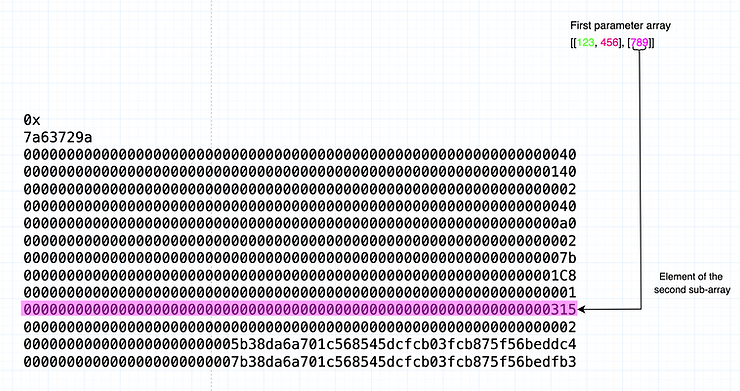
Length of the second array
Finally, we get to represent the length of the second parameter, the address array. We have 2 addresses, so the length is 2; and the two parameters are the addresses represented in this diagram.
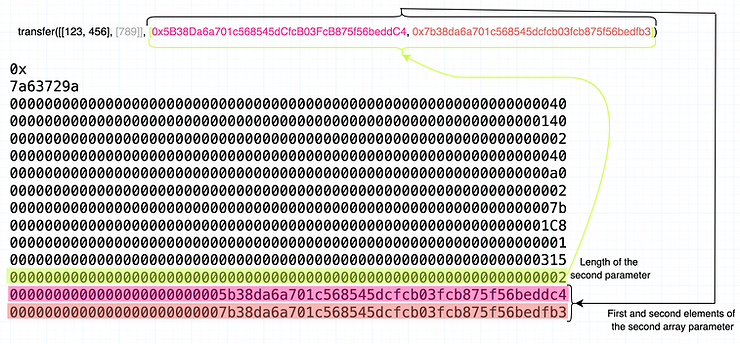
The address items in the second array
And that’s how we convert the function transfer([[123, 123], [123]], [0x5b38da6a701c568545dcfcb03fcb875f56beddc4,0x7b38da6a701c568545dcfcb03fcb875f56bedfb3]) to its Hexadecimal representation for the EVM.
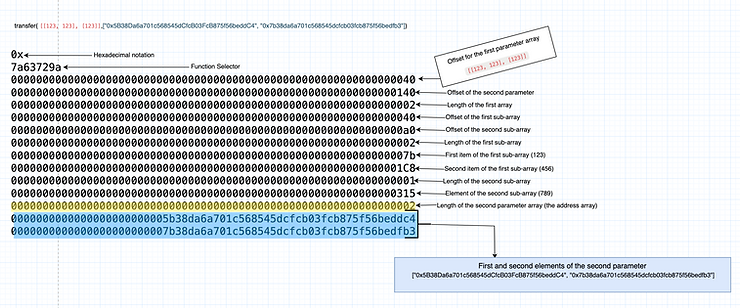
The following video summarizes the calldata from this section’s example:
A triple nested array animation
Below we show a video demonstrating how a 3D uint array is ABI encoding: f(uint[][][] memory data):
Calldata length and gas cost
As a Solidity developer, one of your key concerns is saving gas. More so, working with calldata comes with extra cost — every byte in calldata costs gas.
To determine the cost of a call data we first need to figure out the length of the calldata by counting the bytes. Let’s use our previous calldata string as a case study:
0xa9059cbb0000000000000000000000003f5047bdb647dc39c88625e17bdbffee905a9f4400000000000000000000000000000000000000000000011c9a62d04ed0c80000We’ll first remove the 0x as it’s only a prefix for us to understand that it’s an Ethereum related Hexadecimal. Now, we’ll be left with this:
a9059cbb0000000000000000000000003f5047bdb647dc39c88625e17bdbffee905a9f4400000000000000000000000000000000000000000000011c9a62d04ed0c80000This string is 136 hex digits long, which represents 68 bytes. Each byte is represented by two characters (hex digits) in the calldata string. Therefore, we can calculate the length by dividing 136 by 2 = 68.
Each non-zero byte in calldata costs 16 gas, while zero bytes cost 4 gas. So, we need to separate them to proceed with out calculation.
We have:
- $32 \text{ non-zero bytes} = 32 \times 16 = 512 \text{ gas}$
- $36 \text{ zero bytes} = 36 \times 4 = 144 \text{ gas}$
Total gas cost for calldata $= 512 \text{ gas} + 144 \text{ gas} = 656 \text{ gas}$.
Since zero bytes are cheaper, some developers mine for addresses or smart contract addresses with several leading zero bytes as this reduces the gas cost for passing that address as an argument.
Conclusion
Throughout this guide, we’ve learned the basics of ABI encoding for function calls, the key components of an ABI-encoded function call, and gained a more detailed understanding of calldata. We’ve also explored how to calculate the gas cost of calldata and even went further to explore more complex calldata decoding and encoding excercise to help solidify the knowledge, I hope you found it useful. To further enforce what you have learned in this article, I recommend reading more about the Ethereum ABI encoding spec and practicing the problems in the next section.
Happy encoding!
Practice Problems
- How many bytes are in the calldata for a call to
foo(uint16 x)? - What is the ABI encoding for
foo(uint256 x, uint256[])when passed(2, [5, 9])? - What is the ABI encoding for
foo(S[] memory s)whereSis a struct with fieldsuint256 x; uint256[] a;? (Credit to this tweet for inspiration).
Capture the Flag Exercises
RareSkills Solidity Riddles: Forwarder
DamnVulnerableDeFi: ABI Smuggling
Authorship
This article was written by Eze Sunday in collaboration with RareSkills.
Originally Published May 29